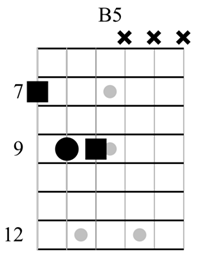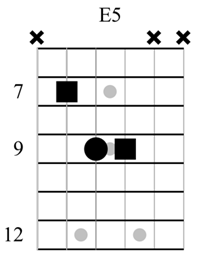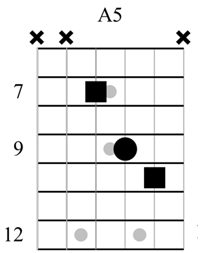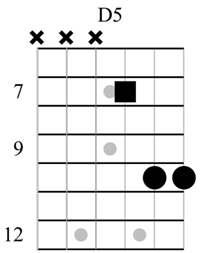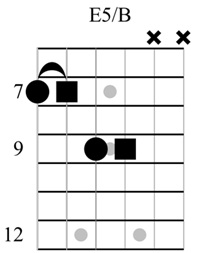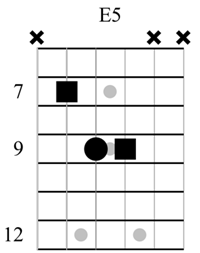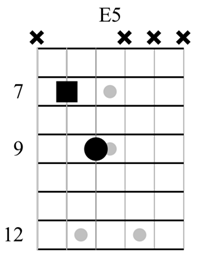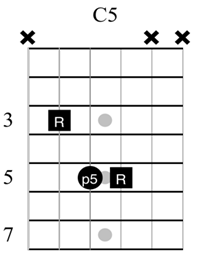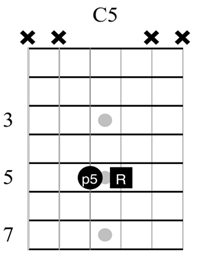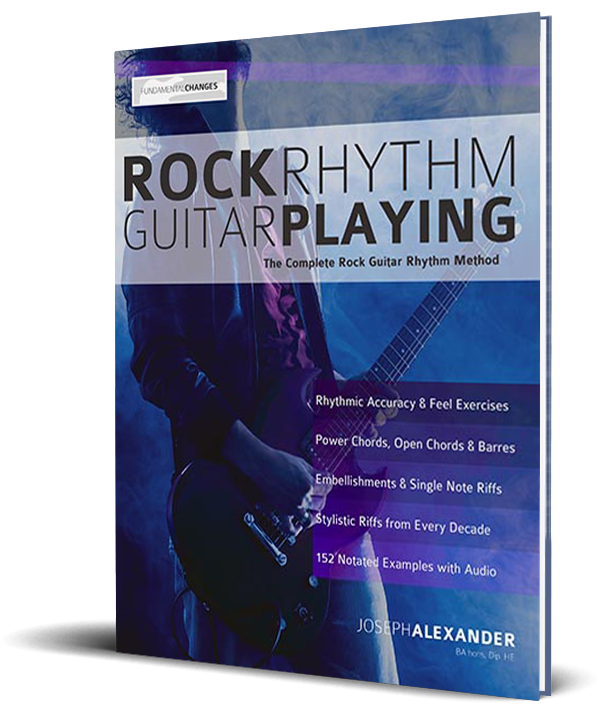Power Chords on Guitar Lesson
Power chords are probably the most commonly used chords in rock guitar and they have been played on thousands of songs in many different genres.
Power chords are popular in rock because not only do they have a heavy sound, they also do not contain the ‘chord defining’ 3rd interval, meaning that they are neither Major nor minor. As power chords only contain the root and the 5th of a chord they sound like a reinforced version of the root note.
You may have seen power chords played with roots on both the 6th string and the 5th string:
However, these chords can also be voiced on the top-string groups. Learn the following voicings:
Be careful which strings you strum. Do not play any strings marked with an ‘X’.
When playing faster rock songs, it is common to combine muting in both hands to keep unwanted strings quiet. For example, if you were playing the E5 chord shown above, you could gently rest your strumming hand on the low E (6th) string of the guitar to mute it with your palm.
When playing chords with a root on the 5th, 4th or 3rd string, it is also normal to allow the 1st finger of the fretting hand to ‘overshoot’ the root note of the chord and make gentle contact with the side of the unused string below. Muting the lower string with the fretting finger allows for slightly less accuracy in the strumming hand.
The high E and B (1st and 2nd) strings are normally muted naturally by the underside of your fretting hand fingers, but be careful not to apply too much pressure here so you don’t create unwanted notes.
Play through the following exercise gradually increasing the tempo. Use a little gain on your amp to help you hear if you’re using the correct muting.
Unused strings should be muted, and only the chord notes should ring.
Power Chords Example 6a:
Although less common, there is another type of power chord that doubles the 5th of the chord and plays it in the bass to produce a thick, recognisableinversion of the power chord.
This chord voicing was used to great effect by one of the greatest guitarists of the last century. Check out the following example:
Power Chords Example 6b:
Splitting the Chord
A popular technique that creates texture is to ‘split’ the chord into two separate parts: the bass note and the actual chord notes, rather than strumming the whole chord at once. The technique is shown here with power chords, but you should try it with any of the chord ideas later in this section.
Play only the bass note of the chord on beats 1 and 3 and then fill in the rest of the chord on beats 2 and 4.
Power Chords Example 6c:
Notice the ‘scratched’, muted notes in the previous example that give more forward motion to the riff. To perform these scratches, continue to hold the chord but reduce the pressure with your fretting fingers so that they are just resting on the strings. When you pick the strings you should get a muted effect as heard in the audio example.
Rock guitarists are continually (and unconsciously) changing the pressure used in the fretting hand to shift between muted and full chords. This creates exciting dynamics and texture in the rhythm guitar part.
The chord splitting technique can be reversed by playing a full chord on the beat and filling in the rhythm with repeated bass notes.
Play the following example using all downstrums.
Power Chords Example 6d:
Another useful technique is to combine full strums with individually picked notes in each chord.
Power Chords Example 6e:
All these techniques can be combined to create rich, interesting musical textures. Notice the ‘pushed’ chord in the last beat of each bar pre-empts the chord change.
Power Chords Example 6f:
Power chords don’t always have to be played as a three-note voicing with a doubled root note, in fact, they are often played with just the root and 5th. Compare the sound of the following two chords when played with high distortion:
Power Chords Example 6g:
Playing with high gain or distortion actually adds to, and enhances the harmonic overtones or ‘range’ of the chord being played, so it can often be desirable to reduce the number of notes we play so as not to overpower the rest of the band.
The second, two-note voicing of the E5 power chord normally sounds more ‘focused’ than the first as it generates fewer harmonic overtones.
If you refer back to example 6b, you will see that the root of a power chord does not have to be played in the bass.
Compare the following two voicings of C5.
As you can see, the second chord is a two-note voicing of the C5 chord with the 5th in the bass. As simple as it may seem, this is one of the most important chord voicings in rock guitar because of the following type of riff:
Power Chords Example 6h:
As you can hear, this type of power chord voicing has a crisp, articulate tone.
This power chord voicing can be shifted across onto the 5th and 4th strings for a deeper, more resonant tone. These mini voicings were popular with Mark Knopfler. Use your first finger throughout:
Power Chords Example 6i:
Two-note power chords played on the 4th and 3rd strings regularly occur in rock, and they’re great fun to experiment with. Dial in some crunch and write a few of your own riffs using just these voicings.
Here are two to get you started:
Power Chords Example 6j:
The final few notes of the previous example form a fill that both adds interest and helps the lick to loop more smoothly. Using lead lines in rhythm guitar parts will be discussed further in chapter eight.
Power Chords Example 6k:
Finally, returning to the ‘standard’ power chord shape on page 42, there is another common movement that was popular in ‘80s rock, with players like Eddie Van Halen and Nuno Bettencourt all using this idea.
The technique is to stretch the first finger down a fret from the starting position, before returning to the original chord. Learn the following example with the two-note power chord shape as written, but then try re-fingering it to use the full, three-note power chord shape.
Power Chords Example 6l:
This lesson is an extract of my book, Rock Rhythm Guitar Playing, available now on Amazon:
“The artists you work with, and the quality of your work speaks for itself.”
Tommy Emmanuel
© Copyright Fundamental Changes Ltd 2025
No.6 The Pound, Ampney Crucis, England, GL7 5SA

